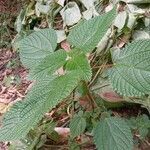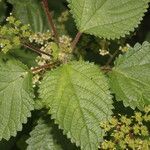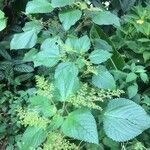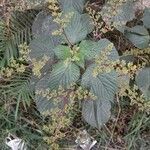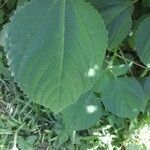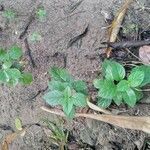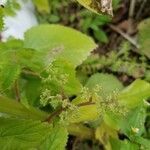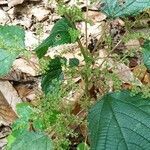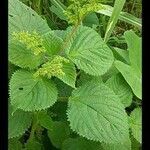Herbs annual, monoecious. Stems erect, few-branched, to 1.3 m tall; upper stems and petioles densely armed with stinging hairs and long gland-tipped hairs. Stipules ca. 10 mm, apex 2-cleft; petiole 7-11 cm; leaf blade broadly ovate, 8-17 × 6-13 cm, thinly papery, 3-veined, lateral basal pair reaching middle margin, lateral veins 3 or 4 each side of midvein, both surfaces armed with stinging hairs, denser on abaxial surface, base rounded or cordate, margin dentate, apex acuminate; cystoliths punctiform, adaxially conspicuous. Inflorescences axillary, often bisexual, rarely all male, paniculate, male inflorescences in proximal axils, shorter, bisexual inflorescences in distal axils, 10-20 cm, peduncle 7-14 cm, with stinging hairs and often long gland-tipped hairs. Male flowers pedicellate, in bud ca. 1.5 mm; perianth lobes 4 or 5, connate at base, cymbiform, with a few long gland-tipped hairs and sparsely setulose, apex corniculate; stamens 4 or 5. Female flowers: pedicel ca. 2 mm, not winged; perianth lobes 4, free, unequal, dorsal lobe ovate, ca. 0.25 mm, 2 lateral lobes largest, enclosing the ovary, broadly ovate, ca. 0.5 mm, ventral lobe minute. Ovary asymmetrically ovoid; stigma slightly reflexed, ligulate, ca. 0.3 mm. Achene obliquely ovoid, compressed, ca. 1.5 mm in diam., both central surfaces with inconspicuously warty depression; persistent lateral perianth lobes forming a small, basal cup. Fl. Aug-Sep, fr. Oct-Nov.
Herb up to 2 m tall, branched or unbranched. Stem succulent, when dry 2-8 mm thick, with stinging and/or glandular hairs. Stipules 0.2-1.2 cm long, sparsely puberulous; petiole (0.5-)1.5-10(-15) cm long; blade papyraceous, broadly or narrowly ovate, (1.5-)7-21 x (1-)4-17 cm, apex acuminate, base rounded to subcordate or to acute, margin serrate-crenate to-dentate, both surfaces with sparse (stinging) hairs; secondary veins 2-6 pairs. Inflorescences in the leaf axils or also on the leafless parts of the stem, up to 25 cm long. Staminate flowers with up to 1 mm long pedicel; tepals ca. 1 mm long, with 2-5 stinging or glandular hairs at the apex. Pistillate flowers with up to 0.5 mm long pedicel; tepals ca. 0.5 mm long, the larger (dorsal) tepal with 2-5 stinging or glandular hairs; stigma 0.2-0.3 mm long. Achene ca. 2 x 2 mm.
Herbs , annual, 1-10 dm, sparsely to densely pubescent with stinging hairs and stipitate-glandular, nonstinging hairs. Leaf blades broadly ovate to nearly orbiculate, 9-20 × 6-16 cm, base rounded or abruptly attenuate, auriculate, margins regularly serrate or dentate, apex short-acuminate. Inflorescences with both staminate and pistillate flowers in same panicle, or proximal panicles with staminate flowers. Staminate flowers ca. 2 mm across; tepals 4-5, equal in length; stamens 4-5, opposite tepals; filaments longer than tepals. Pistillate flowers ca. 0.7 mm; tepals 2-4, appressed, inner pair ca. 1/2 length of ovary; ovary ovoid to ellipsoid; style persistent, hooked and beaklike, ca. 0.2 mm, becoming knoblike in fruit. Achenes strongly compressed, ± orbicular, ca. 0.9 × 1.3 mm.
A herb. It grows 1.5 m high. The stems are woody below and fleshy above. There are leaves in the upper part. The stem is covered with stinging hairs. The leaves are 10-15 cm long by 8-12 cm wide. They are broadly oval. They taper to the tip. The leaves have stinging hairs. The flowering groups have flowers of both sexes.
Leaves 10–15 x 8–12 cm., ovate to broadly ovate; apex acuminate; base rounded to truncate; margin regularly serrate, with 30–40 teeth per side c. 0.5 mm. long; lamina usually with stinging hairs on both sides but without glandular hairs.
Inflorescences bisexual, mainly in the axils of the uppermost leaves, consisting of profusely branched panicles up to c. 20 cm. long, on peduncles 4–10 cm. long, axes covered with glandular and stinging hairs.
Male flowers intermixed with female flowers or mostly at the base of the inflorescences, soon falling, pedicellate, perianth 4–5-merous, 1–2 mm. in diam., usually with glandular hairs on the outside.
Stems somewhat fleshy above, ± woody below, little branched, leafy in upper part, covered with stinging hairs to c. 1 mm. long and soft glandular hairs 1–2(3) mm. long.
Achenes 1–2 mm. long, ovoid, laterally compressed, with circular and rugose markings on the sides, shortly stipitate, shed without the perianth.
Petiole 5–15 cm. long, usually covered with soft glandular hairs and a few stinging hairs.
Stipules up to 1 cm. long, linear-lanceolate, fused for ± half their length.
Female flowers densely clustered, tepals 4 unequal, pedicel unwinged.
Erect annual monoecious herbs to c. 1 m. tall.
